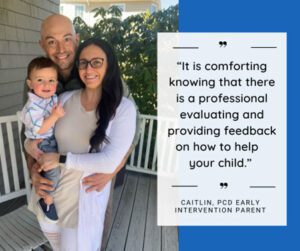The intersection of Mr. Rogers and Reggio Emilia
Beginnings

Sarah Ganong, Director of Woodbridge School, is committed to reimagining the perceptions of early education. Two influences have helped guide her: Mr. Fred Rogers and The Reggio Emilia Approach®. What would the beloved host of “Mister Rogers’ Neighborhood” and an Italian education philosophy possibly have in common? As Sarah explains, both embody tenets that are unwavering at Woodbridge: respect for the child as an individual and fueling a child’s curiosity. “Mr. Rogers was a kind, genuine, respectful person. We bring that kindness, genuine interest, and respect to our Woodbridge students,” Sarah explains.
In the beginning of Sarah’s career, she became aware of The Reggio Emilia Approach® when working at the since closed, John Hancock Child Care Center in Boston. The center implemented the philosophy throughout classrooms and child observations. The Approach can be described as a respectful way of individualizing learning and allowing childhood experiences to be organic. Sarah strives to give Woodbridge students autonomy, celebrating their opinions, thoughts, and feelings but also respecting their time, space, and energy. Sarah has since traveled to Reggio, Italy, where she received extensive training and gained deeper insights into the innovative teaching method.
Respect for the Child
At Woodbridge School, a core belief is that students build confidence through learning and learning originates from their curiosity. The Reggio Emilia philosophy views children as capable, competent individuals with their own ideas and potential, emphasizing that listening to children and respecting their ideas further inspires curiosity. Similarly, and succinctly, Fred Rogers believed in treating children with respect and understanding, acknowledging their feelings and experiences as valid and important. Both philosophies agree that slowing down, taking a moment, and listening to what children are saying and what they’re doing will allow both students and teachers to continually explore and spark new interests.
The Individualized Approach
“Often, when you think you’re at the end of something, you’re at the beginning of something else,” explains Fred Rogers. Mr. Rogers recognized each child’s uniqueness, and his lessons were tailored to be inclusive and supportive of individual differences. The Reggio Emilia philosophy also emphasizes individualized learning paths, recognizing that each child has their own interests, strengths, and ways of learning. Both Fred Rogers and the Reggio Emilia philosophy share a deep commitment to fostering a nurturing, respectful, and stimulating environment for children, focusing on their emotional, social, and intellectual development. And Sarah concurs, “In this philosophy, when you think [your students] are at the end of something, it’s the beginning of something else. It’s the forever scaffolding of learning.”

The Environment is the Third Teacher
The physical environment is considered a crucial element in the Reggio Emilia philosophy and is often referred to as the “third teacher.” The classrooms at Woodbridge School are designed to be inviting, warm, home-like, and conducive to exploration. As Sarah links similarities, the set of “Mister Rogers’ Neighborhood” was also designed to be a comforting, familiar, and stimulating environment for children. He believed that the predictability of his actions, such as always putting on a sweater and changing his shoes, provided a sense of security and comfort. Woodbridge School also looks to be a safe and welcoming environment for children, emphasizing the importance of consistency and the comfort of familiar ritual.
The Emphasis on Relationships and Community
Every morning at Woodbridge School, families are welcomed into classrooms. Teachers consider this a time a time to settle into the transition by putting belongings away and the freedom to explore the room which is set up with activities including art projects and books to read. Woodbridge School embraces the belief that relationships are central to the Reggio Emilia approach, and as such foster relationships between children, teachers, parents, and the community. Collaboration and communication are essential elements between students and between the children and the teachers to reinforce that teachers have each student’s best interests at heart and want to hear what they have to say.
Learning Through Play and Exploration
In the words of Fred Rogers, “Play is learning…it’s the serious work of childhood.” At Woodbridge School in Andover, MA, play is taken very seriously, as it is the basis for learning through exploration, imagination, and hands-on activities. It supports the idea that children learn best when they are actively engaged and curious. As Mr. Rogers used storytelling, songs, and imaginative play to help children understand complex emotions and concepts, the teachers ensure that themes in the classroom remain fluid. Recently a teacher hung a hummingbird feeder outside a classroom. The class became fascinated, and this curiosity turned into the class identifying different birds outside, listening to the birds and then in turn asking more questions. Where do the birds live? What do birds eat? How often do birds eat? These questions turned into art projects of building binoculars, introducing books on birds, actively identifying different birds, and building bird feeders. Art, math, literacy, and science are taught from the genesis of one curiosity.
Focus on Emotional Development
The philosophies of both Fred Rogers and Reggio Emilia embrace the importance of emotional development, helping children express and understand their emotions through various forms. At this age, children’s social and emotional growth is exponential, so the teachers place emphasis on helping students develop tools to identify and navigate feelings. Both philosophies remind us that it is part of the human experience to have feelings. When students are given the space to identify emotions, they learn how to use words to describe them, allow them to think of solutions, and in some situations give them physical outlets for big feelings. Allowing a child to feel their feelings, further gives them space to learn empathy and kindness.
Encouragement of Creativity and Expression
As Director of Woodbridge School, Sarah Ganong embraces the intersection of the philosophies of Fred Rogers and Reggio Emilia and the important roles these influences have had in her career and her directing an early childhood education program that offers a safe, joyful, and creative environment for children to learn through play. The students are learning to work through hard things, build relationships, and learn important life lessons through imagination and curiosity. The Woodbridge School highly values creativity, with children encouraged to express their ideas and feelings through various mediums, including art, drama, and storytelling. Play is vital to feed their imagination and curiosity but also expands their understanding of feelings and experiences.
“The world needs a sense of worth, and it will achieve it only by its people feeling that they are worthwhile.”
–Fred Rogers



